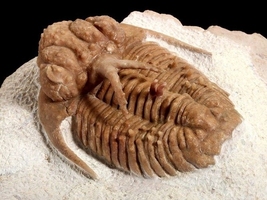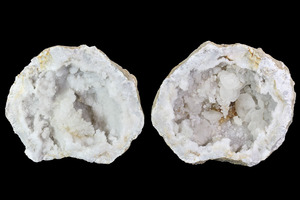Banded Iron Formations (BIF): Ancient Records of Earth's Atmosphere
Banded Iron Formations, or BIFs, are one of Earth's oldest and most intriguing geological records, providing a fascinating window into the planet’s early atmosphere, oceans, and the dawn of life. Formed between 3.8 and 1.8 billion years ago during the Archean and Proterozoic eons, BIFs are known for their distinct alternating layers of iron-rich minerals and chert or silica, which lend them their characteristic striped or "banded" appearance. These formations are both a critical source of iron ore and a key source of insight into early Earth processes, including the rise of oxygen and the emergence of microbial life.
BIFs are sedimentary rocks made up of alternating layers of iron oxides, such as hematite and magnetite, and silica-rich chert. They range in thickness from thin, millimeter-sized bands to several centimeters and even meters thick in some deposits. The most striking feature of BIFs is the rhythmic alternation between metallic and non-metallic layers, which can appear as black, red, and grey banding when exposed in rock outcrops.
Geologically, BIFs are found across the world, with major deposits in Australia, Canada, Brazil, and the United States, particularly in regions like the Mesabi Range in Minnesota. These formations are often found within ancient rock sequences, associated with volcanic and sedimentary rocks, pointing to their origins in ancient ocean environments.
The formation of BIFs is closely tied to the ancient conditions of Earth’s oceans and atmosphere. During the time when BIFs were formed, Earth’s atmosphere contained very little free oxygen. Most of the iron in the oceans was dissolved in its ferrous form (Fe²⁺), allowing it to stay in solution. The exact process of BIF formation remains a topic of debate, but one prevailing theory involves the role of primitive photosynthetic organisms, such as cyanobacteria, which began producing oxygen as a byproduct of photosynthesis.
As these microbes released oxygen into the surrounding water, it reacted with the dissolved iron to form insoluble ferric iron (Fe³⁺) compounds. These iron oxides precipitated out of solution, settling on the ocean floor as thin layers. Over time, this process of iron oxidation and precipitation created the distinctive iron-rich bands we see in BIFs today. Between these layers, silica would also precipitate, possibly influenced by volcanic activity or changes in ocean chemistry, creating alternating bands of chert.
The timing and prevalence of BIFs are closely linked to the Great Oxygenation Event (GOE), which occurred around 2.4 to 2.0 billion years ago. Before the GOE, Earth’s atmosphere and oceans were largely anoxic, and iron could remain in solution in seawater. As photosynthetic organisms gradually increased oxygen levels in the ocean, iron precipitated out, creating layers of iron oxides.
During the GOE, oxygen levels in the atmosphere began to rise more significantly. This led to less soluble iron in ocean water, decreasing the formation of BIFs as free oxygen began accumulating in the atmosphere rather than bonding with dissolved iron. This shift in Earth’s chemistry marked the decline of BIF formation and the transition to a more oxygen-rich environment, enabling the evolution of more complex life forms that rely on oxygen for respiration.
BIFs are a major source of iron ore, which is essential for industrial processes worldwide. The iron-rich layers in BIFs are mined for their high iron content, which can reach up to 60% iron in some cases. The iron extracted from BIFs supports a wide range of industries, from construction and automotive manufacturing to infrastructure development and machinery production. The Mesabi Range in Minnesota, the Hamersley Basin in Western Australia, and the Serra dos Carajás in Brazil are some of the most economically significant BIF deposits, providing much of the iron used in modern industry.
Beyond their industrial importance, BIFs offer valuable insight into the conditions of early Earth and the emergence of life. BIFs are closely linked with the activity of ancient microorganisms, especially early photosynthetic bacteria. By studying these formations, scientists can learn more about the evolution of metabolic pathways that enabled life to utilize sunlight and produce oxygen. BIFs thus serve as a geological record of one of Earth’s most critical transitions: the rise of oxygenic photosynthesis and the gradual oxygenation of the atmosphere, paving the way for more complex life forms.
Today, BIFs are no longer forming because the current levels of oxygen in the ocean and atmosphere prevent the dissolved ferrous iron from accumulating. However, studying BIFs provides scientists with a framework for understanding similar processes that might occur on other planets or moons with liquid water. For example, researchers exploring Mars have considered BIFs as an analog when searching for signs of ancient life or water on Mars.
BIFs also inspire research into biogeochemical cycles, microbial ecosystems, and the evolutionary timeline of photosynthesis. Modern efforts to simulate BIF formation in the lab help geologists understand the environmental conditions that prevailed billions of years ago.
BIFs are sedimentary rocks made up of alternating layers of iron oxides, such as hematite and magnetite, and silica-rich chert. They range in thickness from thin, millimeter-sized bands to several centimeters and even meters thick in some deposits. The most striking feature of BIFs is the rhythmic alternation between metallic and non-metallic layers, which can appear as black, red, and grey banding when exposed in rock outcrops.
Geologically, BIFs are found across the world, with major deposits in Australia, Canada, Brazil, and the United States, particularly in regions like the Mesabi Range in Minnesota. These formations are often found within ancient rock sequences, associated with volcanic and sedimentary rocks, pointing to their origins in ancient ocean environments.
The formation of BIFs is closely tied to the ancient conditions of Earth’s oceans and atmosphere. During the time when BIFs were formed, Earth’s atmosphere contained very little free oxygen. Most of the iron in the oceans was dissolved in its ferrous form (Fe²⁺), allowing it to stay in solution. The exact process of BIF formation remains a topic of debate, but one prevailing theory involves the role of primitive photosynthetic organisms, such as cyanobacteria, which began producing oxygen as a byproduct of photosynthesis.
As these microbes released oxygen into the surrounding water, it reacted with the dissolved iron to form insoluble ferric iron (Fe³⁺) compounds. These iron oxides precipitated out of solution, settling on the ocean floor as thin layers. Over time, this process of iron oxidation and precipitation created the distinctive iron-rich bands we see in BIFs today. Between these layers, silica would also precipitate, possibly influenced by volcanic activity or changes in ocean chemistry, creating alternating bands of chert.
The Great Oxygenation Event (GOE) and BIFs
The timing and prevalence of BIFs are closely linked to the Great Oxygenation Event (GOE), which occurred around 2.4 to 2.0 billion years ago. Before the GOE, Earth’s atmosphere and oceans were largely anoxic, and iron could remain in solution in seawater. As photosynthetic organisms gradually increased oxygen levels in the ocean, iron precipitated out, creating layers of iron oxides.
During the GOE, oxygen levels in the atmosphere began to rise more significantly. This led to less soluble iron in ocean water, decreasing the formation of BIFs as free oxygen began accumulating in the atmosphere rather than bonding with dissolved iron. This shift in Earth’s chemistry marked the decline of BIF formation and the transition to a more oxygen-rich environment, enabling the evolution of more complex life forms that rely on oxygen for respiration.
Economic Importance of BIFs
BIFs are a major source of iron ore, which is essential for industrial processes worldwide. The iron-rich layers in BIFs are mined for their high iron content, which can reach up to 60% iron in some cases. The iron extracted from BIFs supports a wide range of industries, from construction and automotive manufacturing to infrastructure development and machinery production. The Mesabi Range in Minnesota, the Hamersley Basin in Western Australia, and the Serra dos Carajás in Brazil are some of the most economically significant BIF deposits, providing much of the iron used in modern industry.
BIFs and Clues to Early Life
Beyond their industrial importance, BIFs offer valuable insight into the conditions of early Earth and the emergence of life. BIFs are closely linked with the activity of ancient microorganisms, especially early photosynthetic bacteria. By studying these formations, scientists can learn more about the evolution of metabolic pathways that enabled life to utilize sunlight and produce oxygen. BIFs thus serve as a geological record of one of Earth’s most critical transitions: the rise of oxygenic photosynthesis and the gradual oxygenation of the atmosphere, paving the way for more complex life forms.
Today, BIFs are no longer forming because the current levels of oxygen in the ocean and atmosphere prevent the dissolved ferrous iron from accumulating. However, studying BIFs provides scientists with a framework for understanding similar processes that might occur on other planets or moons with liquid water. For example, researchers exploring Mars have considered BIFs as an analog when searching for signs of ancient life or water on Mars.
BIFs also inspire research into biogeochemical cycles, microbial ecosystems, and the evolutionary timeline of photosynthesis. Modern efforts to simulate BIF formation in the lab help geologists understand the environmental conditions that prevailed billions of years ago.
 Reviews
Reviews







